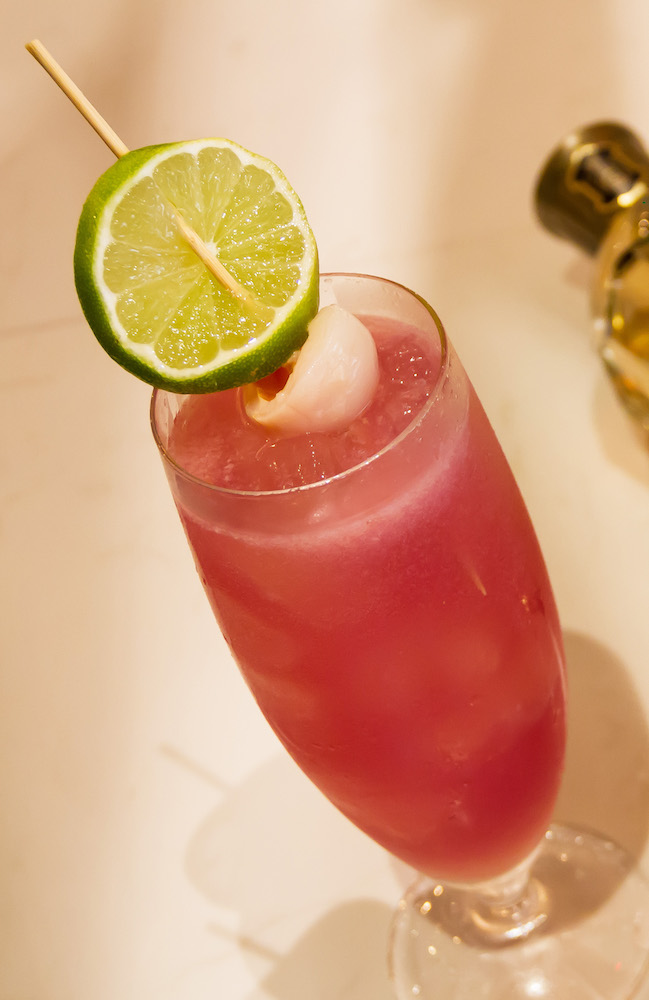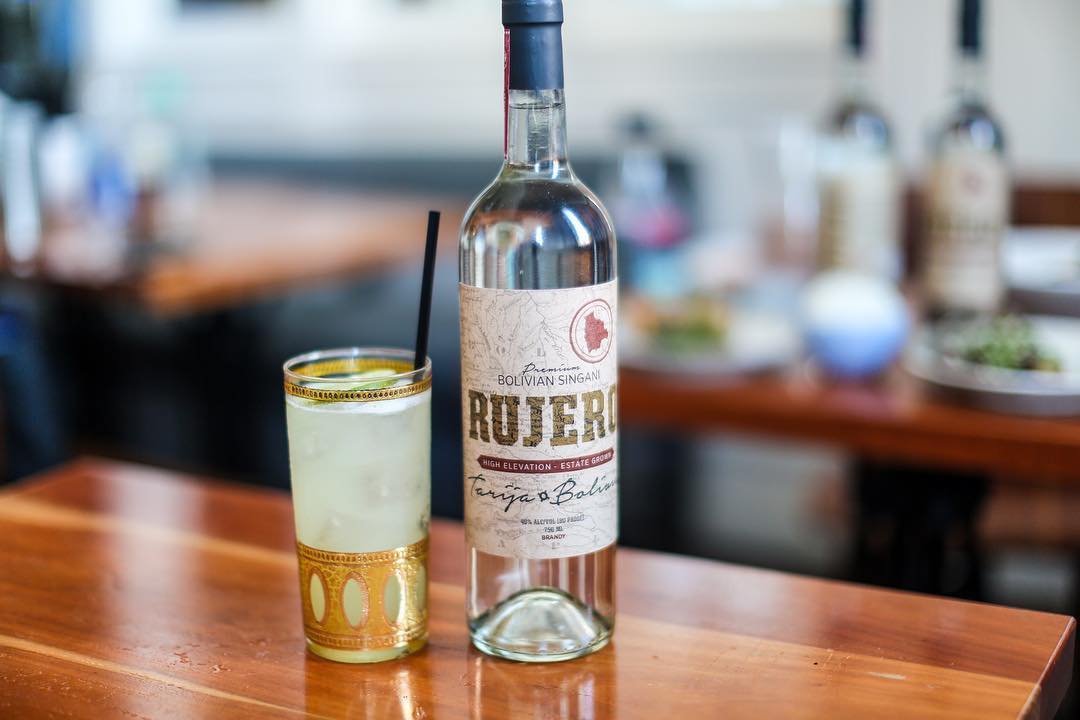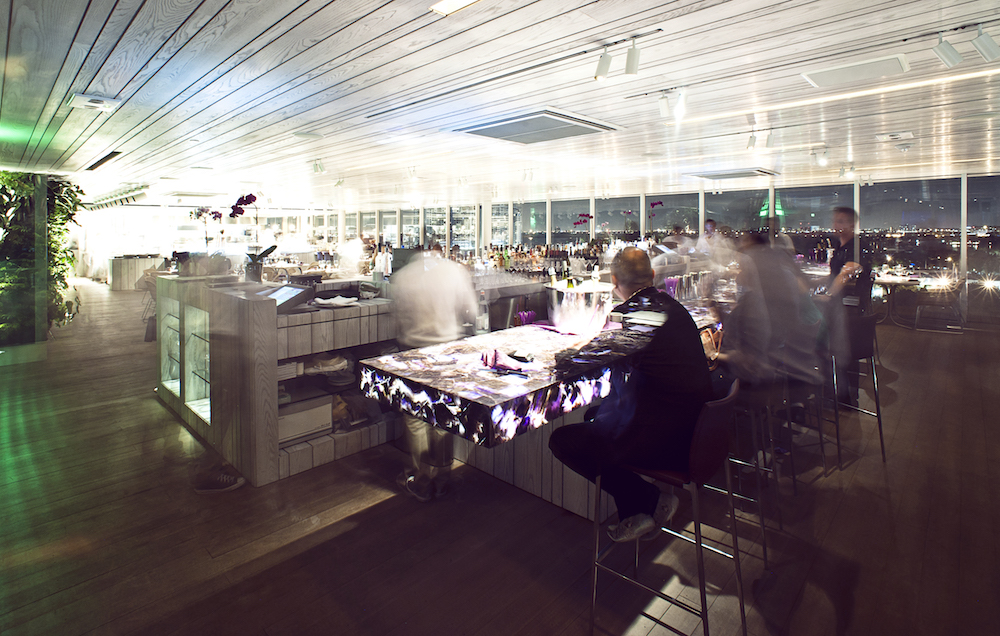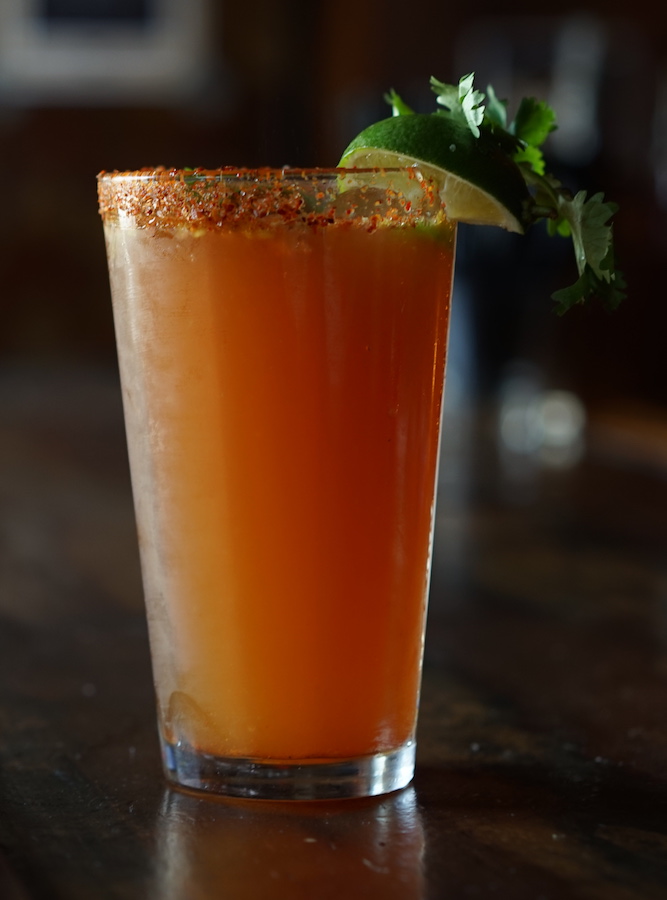Editor’s Note: Since so many beverage trends begin on-premise, we occasionally cross-post content from our on-premise sister publications, Cheers magazine.
As guests become more sophisticated about spirits, they want to learn more about and sample the lesser-known categories, including pisco, singani, cachaça, shochu, soju, baiju and agave spirits beyond tequila. Operators share how they market these more-exotic spirits, from cocktail creation and menu presentation to guest and staff education.
Pisco
Pisco y Nazca, a Florida gastropub with locations in Doral and Kendall, specializes in ceviche and modern twists on Peruvian cuisine. The majority of signature cocktails feature pisco, says beverage manager Joel Mesa.
Pisco Punch ($11, pictured atop) mixes it with fresh pineapple, papaya syrup, Inca Kola and plum bitters; the Guapo’s Chilcano ($11) with fresh lime juice, passion fruit puree, Fever Tree ginger beer, mint and rocoto tincture; Nena’s Chilcano ($11) with lychee puree, fresh lime, St. Germain elderflower liqueur, raspberry-hibiscus syrup and Fever Tree ginger beer; and the traditional Pisco Sour ($11), with fresh lime juice, sugar and pasteurized egg whites.

Though Pisco y Nazca uses Pisco Cuatro Gallos Quebranta in cocktails, the restaurant also offers Bartol Italia, Pisco Porton mosto verde, Kappa Pisco and Pisco Cuatro Gallos mosto verde. Most guests view it as a Peruvian spirit largely used for cocktails, Mesa says. (Chile is a major producer of pisco.)
“We’ve done cocktail tastings for guests that displayed the wide range of flavors that can be produced from pisco,” he explains. “We’ve also done a cocktail class that was interactive [where] they had an opportunity to make some cocktails with us.”
Recent trends in Peru have seen the use of exotic fruit and ingredients from the Amazon rainforest. Mesa believes pisco works well with anything with ginger, passionfruit or lime. It’s also positioned as a sipping spirit, especially the higher-end sub-category of mosto verde pisco. “Fermentation is stopped early and thus leaves some residual sugar, making it easier to sip and perhaps a little less harsh,” Mesa explains.
The Piscobar at the Catahoula Hotel in New Orleans strives to carry every pisco available in the market at any given time. Its piscos range in price from $3.50 to $20 for a 1-oz. pour of Macchu Pisco Nusta, an ultra-premium mosto verde made from the Italia grape and packaged in a handcrafted ceramic bottle.
The bar’s current menu has 13 different pisco cocktails all priced at $12. They range from the big three traditional drinks (Pisco Sour, Pisco Punch and Chilcano) to “whatever flavors we’re geeking out over at the time,” admits beverage director Geoffrey Ian Ward.
The Back Page cocktail adds pisco to banana liqueur, blanc vermouth and lemon, while the Band of Outsiders stirs it with mastiha, Cocchi Americano, bitter orange and rosemary. Since the hotel entertains guests from all over the world—including Peru and Chile—customer knowledge of pisco varies greatly.
“We often enjoy the benefit of engaging with guests who have no preconceived biases or opinions,” Ward says. Piscobar also exists “as a taste of home, something familiar in a strange land.”
A paragraph on the menu introduces pisco; Piscobar also offers a four-pour flight of piscos for $10. The servers that deliver the flight will provide information on the different styles of pisco.
Piscobar constantly educates its staff about the spirit category through tastings and presentations from distillers and reps. Ward predicts that pisco is going to be huge in the next five years, comparing it to the prevalence of mezcal now to just a brief time ago.
“For such a raw, unaged spirit, there is a lot of diversity in flavor from varietal to varietal,” Ward says. This makes pisco highly malleable with everything from citrus and big fruit to coffee, chocolate and spice. “There really is a pisco out there for everyone, and it’s a fun adventure to go seeking out the perfect one for you.”
Singani
The national drink of Bolivia, singani is an unaged brandy distilled from aromatic muscat of Alexandria grapes grown at high altitudes of around 6,000 ft. It’s been produced since about 1830. But it wasn’t until a few years ago that it really hit the U.S. radar, when director Steven Soderbergh released Singani 63.
Soderbergh discovered singani in 2007 when his Bolivian casting director Rodrigo Bellot gave him a bottle on the set of Soderbergh’s movie Che. He brought Singani 63 to the market about seven years later and it’s been gaining a following in major markets. “So far, I think [singani] has infiltrated the market in a very natural way, without heavy passing trends,” says Carlie Steiner, co-owner/beverage director for Himitsu, a 24-seat restaurant in Washington, D.C. featuring Japanese and other Asian fare. “I hope to see that continue for the sake of singani and the economical development it will provide.”
Steiner offered a singani pop-up last year, with classic cocktails and straight pours of Rujero singani at affordable prices to make the category approachable to guests.
The Uyuni Salt Flats cocktail ($15) mixes singani with lime, ginger, pineapple and a pinch of salt, while the Chufly ($12) tops singani with lime, ginger and soda water. Himitsu offers a neat pour of Rujero singani for $10.
“It pairs naturally with ingredients that contain capicum, with fruits and citrus just like any other white spirit and with fortified and aromatic wines,” Steiner says of singani. She also likes to use it in Martini variants.
She admits that guests are still learning about the category, but believes that singani awareness is heightened at Himitsu, as it’s still all over the menu. Staff describe singani as an unaged Bolivian brandy with a flavor profile of pink peppercorns, citrus and white flowers.
Steiner’s favorite singani food pairing? It’s relatively simple, yet sublime: “You must try it with warm, aromatized olives!”

Cachaça
This Brazilian spirit, indispensable in the classic Caipirinha, is distilled from freshly pressed sugarcane juice instead of molasses. This gives cachaça a more vegetal, grassy, herbaceous flavor compared to rum.
“We encourage staff to recommend cachaça as a substitute for other spirits like rum, mostly so guests can experience its versatility,” says Zarko Stankovik, beverage director at the 240-seat Juvia Miami Beach and the 99-seat Sushi Garage.
The operation trains staffers on cachaça production and how it compares and contrasts with rum. Most employees don’t immediately know it’s made with sugarcane juice, Stankovik admits.
Juvia offers Leblon cachaça for $12 a pour; it’s also used in the Caipirinha as well as the signature cocktail the Telenovela ($17) where it’s combined with mezcal, lime, agave, passion fruit puree and cilantro.
Cachaça mixes well with tropical fruits, citrus and herbs.Stankovik recommends it with any of Juvia’s ceviches including Spanish Octopus Anticucho ($27) or Pork Tacos ($18).
Offerings from some brands do see the inside of a barrel, including Avua Amburana (matured in Brazilian amburana wood, which imparts savory and fruity notes) and Cuco Ouro (aged in native jequitiba wood for a spicy, nutty flavor), he says.
At the 56 locations of churrascaria Texas de Brazil, staff starts off every table’s dining experience with a short primer on the Caipirinha, including how it’s Brazil’s most famous cocktail and what’s in it. Servers also explain the brands of cachaça the chain offers (Pirasununga 51 or Leblon), and a choice of Caipirinha flavors (traditional, passion fruit, mango, strawberry or coconut.)
Restaurants also offer riffs on classic drinks such as the Brazilian Mojito, Rio Cosmo and the Ipanema Margarita. (Prices vary depending on location.) Director of wine and spirits Rodrigo Davila says that sales of cachaça drinks grow annually. The acidity in the Caipirinha complements Texas de Brazil’s marbled meats like picanha and flank steak, he notes.

Shochu/Soju/Baiju
These Asian spirits are among the most widely sold in the world. Shochu is distilled in Japan from rice, barley, sweet potatoes, buckwheat or brown sugar; soju is the Korean equivalent. Baiju is made in China from fermented sorghum or sometimes from rice, wheat, barley or Job’s tears.
The spirits are still finding their footing in the U.S. but can be spotted on menus as a shot, neat pour or in cocktails.
At the recent Cherry Blossom PUB (pop-up bar) in Washington, D.C., the Chu-Hi ($13) mixed shochu with Manzanilla sherry, rice orgeat, lemon and sparkling water, topped with a citrus Rice Krispies treat. At Peachy’s, a lively cocktail bar in New York’s Chinatown, Born on the Baiju is a Chinese-inspired Piña Colada with baiju, lime, pineapple, Coco Lopez, spirulina and blue algae.
Billie Jean’s in St. Louis offers four types of soju: Soju Classic, Soju Fresh and Soju Grapefruit from Jinro out of South Korea are priced at $3 for a 2-oz. pour and $13 for a 375-ml. bottle. West 32 Soju, made in New York in a Korean style, sells for $5 for a 2-oz. pour and $20 for a 375-ml. bottle.
“Soju is arguably the most asked-about component of our beverage program,” says general manager/beverage director William Brawley. “Our staff does a beautiful job of explaining to our guests what soju is, how it can be enjoyed, and its faculty as a component in cocktails.”
The most popular cocktail at Billie Jean’s is the Seoul 75 ($13), an interpretation of the classic French 75. It’s made with with Jinro Soju Grapefruit, Fords Gin, lemon and simple syrup, topped with Finke’s Widow California sparkling wine and garnished with an expressed lemon twist.
“Soju readily mixes with effervescence, fresh citrus, and spring flavors,” Brawley explains. “It embraces the components you mix with it, while maintaining the integrity of the distinct soju taste.”
Agave Spirits Beyond Tequila

When La Cuevita in Los Angeles first launched its full mezcal program about six years ago, most people didn’t even know what the spirit was, admits bar manager Sol Trece. Some thought it was a cheap tequila, others a more expensive one, she notes. “[Others] may have remembered a wild night having some really bad mezcal with a worm.”
That’s changed. “The era of absolute ignorance is behind us, [and guests] have a much higher respect for mezcal today than they did a few years ago,” Trece says.
La Cuevita stocks more than 90 different kinds of mezcal, including 35 unique bottles with prices ranging from $8 to $40 per pour, as well as some sotol, raicilla and bacanora. Most cocktails contain mezcal, either as the base or a modifier, to remind guests of the concept’s focus.
Drinks include classics like the Smoky Margarita ($10) and Mezcal Mule ($11), both made with Los Javis Mezcal Silver, or a Mezcalada ($10) with roasted poblano peppers, clamato juice, Mezcal El Silencio, lime, Corona and a house-smoked-salt rim.
More eclectic cocktail options include the Malditos Secretos ($12) with Mezcal El Silencio, Ancho Reyes chile liqueur, Jamaica flower lime and agave. “It’s such a versatile spirit that the possibilities are limited only by your imagination,” Trece says.
La Cuevita strives to teach staff a little about agave spirits each day through visits from brand ambassadors or producers. Trece accompanied employees on a trip last year to Santiago Matalan in Southwestern Mexico. This provided them better understanding and respect for mezcal that they could share back at the bar.
Sotol is also popping up more and more at bars, Danny Mena has noticed. The cofounder of Mezcales de Leyenda has noticed sotol used in fresher, lighter drinks. “The grassy, herbaceous tones lend itself very well in citrus-forward cocktails.”
At the modern Mexican restaurant La Loncheria in Brooklyn, the El Broucklyn ($13) mixes Sotol Fabriquero with maraschino liqueur and dry vermouth.
Sotol is distilled from the Dasylirion wheeleri grown at high altitude in northern Mexico and harvested after 15 years. Its flavor varies depending on producer, type of plant and region, Mena says: Those from from Chihuahua are grassy, while sotol made in Durango has an earthier, smokier side.
Because it’s less familiar than tequila or mezcal, sotol is often hand-sold, Mena notes. “Putting it on cocktails always helps start the conversation, but really once you taste it neat, you start to see and taste the descriptors.”
Kelly Magyarics, DWS, is a wine, spirits and lifestyle writer and wine educator in the Washington, D.C. area.









